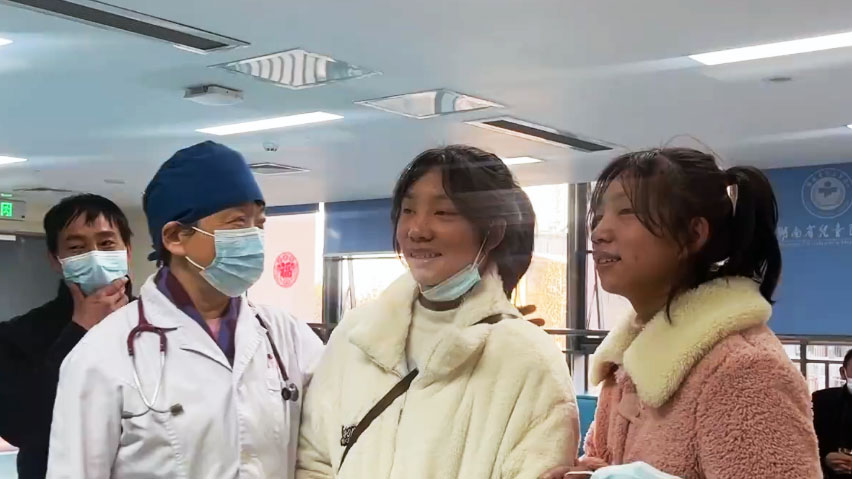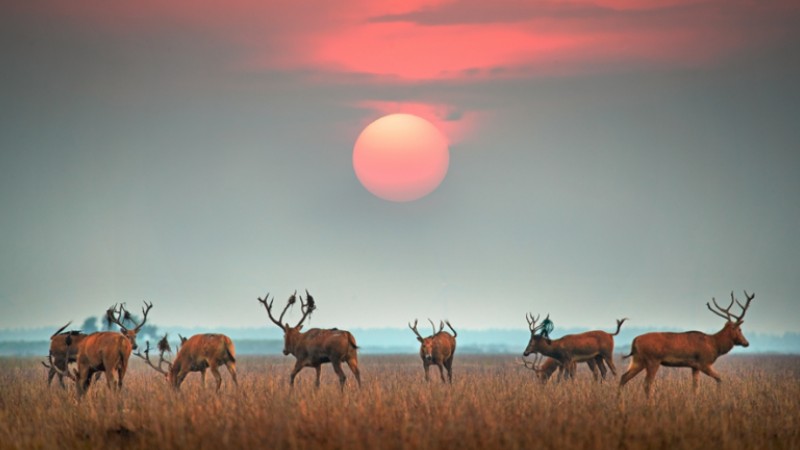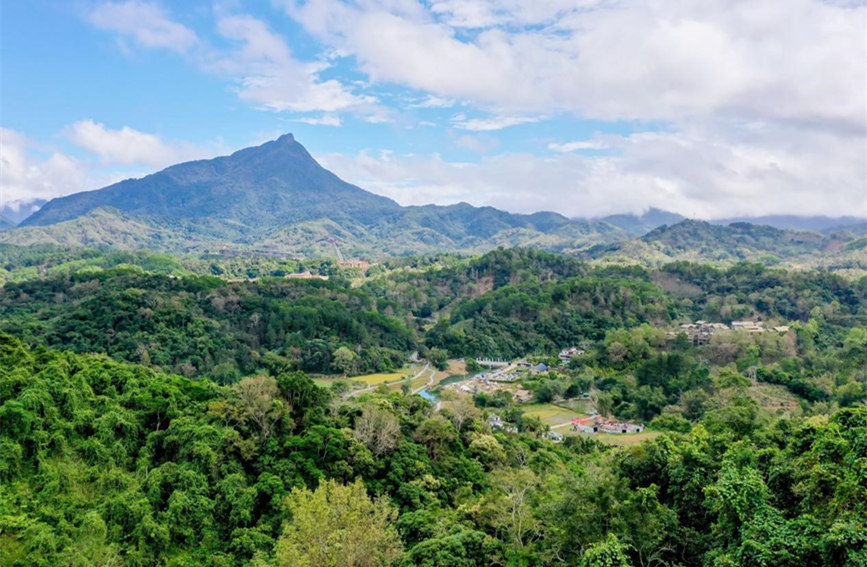Winter sports boom brings brighter future for Xinjiang residents
URUMQI, Feb. 8 (Xinhua) -- For Biregul, a woman from Hemu Village in the Altay Mountains in northwest China's Xinjiang Uygur Autonomous Region, winters used to mean uninterrupted silence.
But in 2021, when a ski resort opened just 5 km away from her home, things began to change, and the road outside her house gradually grew active.
The road stretches through the Altay Prefecture, linking the county seat of Burqin with Hemu, where the snow season lasts for more than five months and the snowdrifts are several meters deep.
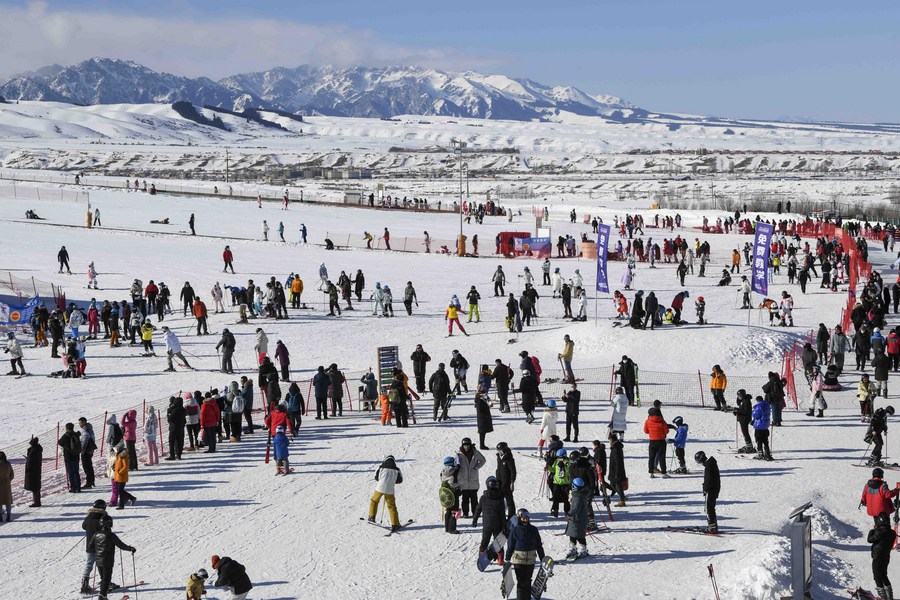
People ski at the Silkroad Resort, one of the largest ski resorts in Urumqi, northwest China's Xinjiang Uygur Autonomous Region, Jan. 25, 2023. (Xinhua/Hu Huhu)
During the winter sports season, a steady stream of vehicles with snowboard bags strapped to their shining luggage racks can be seen driving down the road.
The ice-and-snow sports fever sparked by the Beijing 2022 Winter Olympics has certainly not faded away, with the mega sporting event leaving a profound effect on the Chinese people's way of life and bringing about tremendous changes to the Chinese economy and society.
Xinjiang, which boasts favorable natural conditions and multiple high-standard ski resorts, has taken the starring role in the booming industry to become one of the country's most popular winter tourism destinations. Local people have also found new employment and business opportunities, leading to a better quality of life.
FUN WITHOUT AGE LIMIT
Su Yiming, a Chinese snowboarding prodigy, bagged a big air gold with two 1800 showpieces at the Beijing 2022, knocking countless young Chinese skiers dead.
Among them is 6-year-old Nie Rongchen from Xinjiang, who is already enjoying his fourth year of snowboarding and skiing and able to gallop down the slopes of nearly 30 degrees on his snowboard. During the snow season, his snowboards and skis have left their marks on various ski resorts in Altay and the regional capital Urumqi.
At present, Xinjiang has five ski resorts with the highest level of rating in the mountainous areas of Tianshan and Altay.
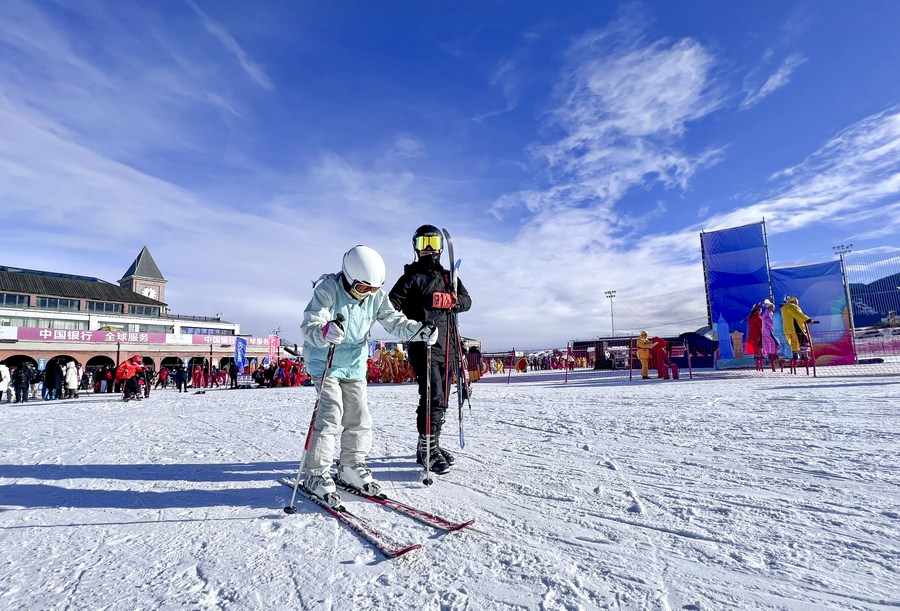
Liu Zhihua (L), an elderly woman, practises skiing at the Silkroad Resort, one of the largest ski resorts in Urumqi, northwest China's Xinjiang Uygur Autonomous Region, Dec. 14, 2022. (Xinhua/Zhou Ye)
According to data from Xinjiang Altay Tourism Development Group Co., Ltd., the ski resorts of Jiangjunshan, Koktokay and Jikepulin, under the company's management, received a record 10,178 skiers on Jan. 25.
At the Silkroad Resort, one of the largest ski resorts in Urumqi, Liu Zhihua joined the crowd and tore down the piste, skiing vigorous into the ripe old age of 88.
Liu took up the sport in 2007 at the age of 72. Up until then, like many elder Chinese people, she would spend her days taking care of her grandchildren, watching TV, or playing mahjong.
For Liu, skiing is a way to keep herself young and lively. These days, she skis for about two hours at a time under the supervision of her instructors. "I'd rather fall on a piste than lie on a sickbed," said Liu with a playful smile, adding that she is determined to continue the hobby as long as possible.
Thanks to its long snow season, good snow quality and diverse terrain, Xinjiang has gained enormous sporting popularity in recent years, attracting tens of thousands of skiing enthusiasts.
Last snow season, Peng Chao rented a wooden house in Hemu and turned it into a work site for his entrepreneurial team involved in ski gear evaluation and popularization of skiing knowledge.
"High mountains, thick snow layer, long snow season and powder snow, which is ski lover's favorite, made the village a favorable workplace for us," said Peng, a seasoned skier with abundant skiing experience in global winter sports destinations.
Espying the ballooning development of ice and snow sports in China, Peng concluded that the market will continue to expand and upgrade, and as the number of skiers increases and their skills improve, many more will pursue a higher level of skiing experience.
"Their destination will be Altay, and we will be waiting for them here," he said, brimming with confidence.

Nie Rongchen, a young boy, enjoys snowboarding in the ski resort of Koktokay, northwest China's Xinjiang Uygur Autonomous Region, April 27, 2022. (Xinhua)
NEW CHOICES, NEW PROSPECTS
Mayirbek Chihsi, who comes from a long line of herdsmen and has lived in the mountains of Koktokay Township in Altay Prefecture's Fuyun County for generations, became the first skiing rescuer in his family.
In 2018 the Kazakh young man completely left nomadic life and started to work at a local ski resort. Boasting an experience of skiing on wooden planks covered with fur when he was a kid, Mayirbek Chihsi soon became a certified ski instructor and a ski rescue worker within two years.
The rescue team Mayirbek Chihsi heads recruited 22 members, all former herdsmen who are skilled in skiing and familiar with the local terrain. During the past few years, they have helped dozens of skiers trapped in heavy snow.
This year, Koktokay was included as one of 19 state-level skiing destinations nationwide.
By the end of the 2024-2025 ice and snow season, China's ice and snow leisure tourism sector is expected to receive over 520 million visitors, with its revenue exceeding 720 billion yuan (about 106 billion U.S. dollars), making the sector a core development engine for winter tourism and ice and snow economy, said an annual report on China's ice and snow tourism development, released by the China Tourism Academy.
Taking advantage of this growing momentum, an increasing number of Xinjiang residents plan to expand their businesses and ride the winter sports boom.
The Silkroad Resort, located in the regional capital, alone has provided more than 500 jobs for farmers and herdsmen of more than 20 villages, not to mention more than 300 ski instructors and 114 members of catering service staff.
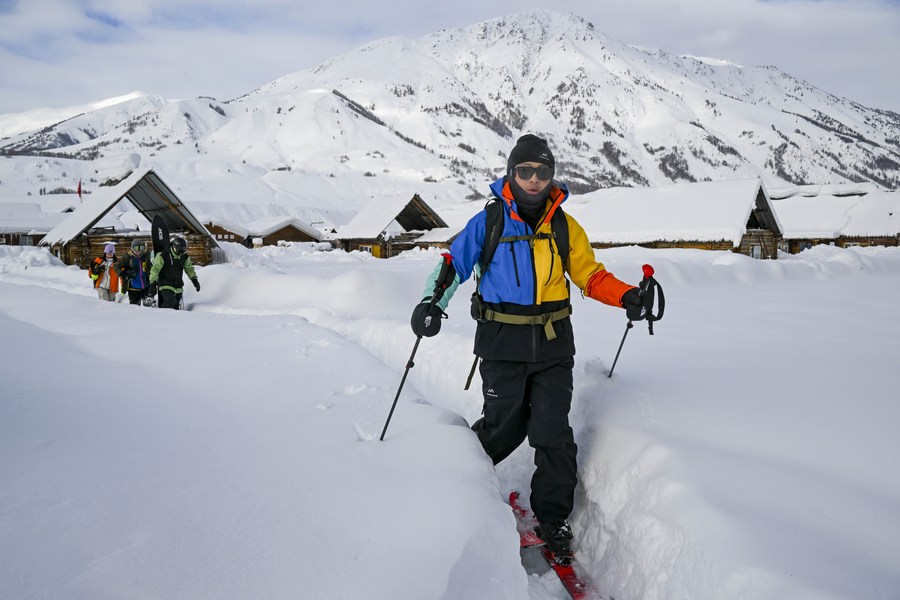
Peng Chao, a seasoned skier, leads skiing enthusiasts on the way to a ski spot in Hemu Village of Kanas in Altay, northwest China's Xinjiang Uygur Autonomous Region, Jan. 14, 2023. (Xinhua/Hu Huhu)
Biregul from the Hemu Village has been running a homestay at her family's wooden house since 2018. "Years ago, there were few tourists in the winter. Considering the low occupancy rate and the heating and labor costs, we once chose to go out of business," she said.
The opening of the Jikepulin ski resort last snow season increased the number of winter sports enthusiasts seeking lodging in the area. Her homestay is just one of many popping up across the area. There are 113 homestays with more than 3,000 beds in operation in Hemu this winter, according to the administrative committee of the Kanas scenic area.
From 2016-2017 to the 2021-2022 snow season, the number of tourists in Altay surged from 1.94 million to 11.96 million, and tourism revenue jumped from 1.17 billion yuan to 10.29 billion yuan, statistics from the prefectural authorities showed.
"Those who come to ski stay for three or five days at least, and two weeks at most," she said, adding that advance bookings were made for rooms from New Year's Day to the Spring Festival holiday.
Photos
Related Stories
- Picturesque scenery of Kanas scenic area in Altay, NW China's Xinjiang
- National Biathlon Championships closes in NW China
- Wondrous Xinjiang: Busy land ports herald thriving foreign trade
- Employees in cotton mill return to work in NW China’s Xinjiang
- Alpine ibexes roam nature reserve in NW China's Xinjiang
Copyright © 2023 People's Daily Online. All Rights Reserved.







